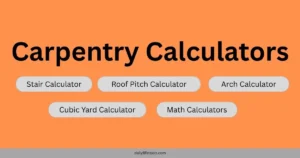Carpentry combines creativity and precision, but math often intimidates beginners. Enter carpenter calculators, tools designed to turn complex calculations into simple steps. Whether building a shelf or framing a house, these calculators save time and reduce errors.
This guide explains everything you need to know about understanding carpenter calculators, including their features, usage, and benefits.
Table of Contents
What Is a Carpenter Calculator?
A carpenter calculator (or construction calculator) is a specialized device for solving math problems unique to carpentry. Unlike regular calculators, it handles feet-inch-fraction units, roof pitches, stair angles, and material estimates. These tools are built for jobsite efficiency, ensuring accurate results even in challenging conditions.
For example, you need to calculate the diagonal of a rectangular frame. A standard calculator might give you a decimal like 8.66 feet, but a carpenter calculator converts this into 8 feet 7 15/16 inches, a measurement you can directly use with a tape measure 1.
Why Use a Carpenter Calculator?
- Accuracy: Reduce human error in measurements, crucial for large projects.
- Speed: Perform calculations 2-3x faster than manual methods.
- Specialized Functions: Solve carpentry-specific problems like rafter lengths or concrete volumes.
- Unit Flexibility: Convert between metric, decimal, and fractional systems effortlessly.
- Cost Savings: Minimize material waste with precise estimates.
Let’s dive deeper into each benefit:
1. Accuracy: Avoid Costly Mistakes
Manual math leaves room for errors. For instance, adding 3 feet 9 inches + 2 feet 6 inches might result in 6 feet 3 inches on paper, but a miscalculation could lead to wasted wood or misaligned structures. A carpenter calculator ensures precision, even for complex tasks like calculating compound angles for crown molding.
2. Speed: Save Hours Every Week
Imagine calculating the volume of concrete needed for a 20×30-foot patio. A regular calculator requires converting inches to decimals and multiplying manually. A carpenter calculator does this instantly, giving you cubic yards in seconds. Over time, this speed adds up, saving hours on large projects.
3. Specialized Functions: Solve Carpentry-Specific Problems
Carpenter calculators include pre-programmed formulas for tasks like:
- Roof Pitch: Calculate slope ratios (e.g., 4:12 pitch).
- Stair Building: Determine step height and tread depth.
- Material Estimation: Count how many 2x4s you need for a wall.
These functions eliminate guesswork, making them essential for professionals and hobbyists alike.
4. Unit Flexibility: Work Seamlessly Across Systems
Most carpenters work in feet and inches, but some projects require metric units. A carpenter calculator switches between systems with a single button press. For example, converting 5 feet 6 inches to meters gives 1.68 meters instantly.
5. Cost Savings: Avoid Overbuying Materials
Overestimating materials leads to waste. A calculator ensures you order exactly what’s needed. For instance, calculating the square footage of a deck tells you how many planks to buy, reducing leftover wood.
Common Features of Carpenter Calculators
Modern carpenter calculators boast features tailored to construction needs. Here’s what to look for:
1. Dimensional Math
Work directly in feet, inches, and fractions. For example:
- Problem: Add 4 feet 3 inches and 2 feet 9 inches.
- Solution: 4 FT 3 IN + 2 FT 9 IN = 7 FT 0 IN.
No need to convert to decimals first!
2. Right Angle Calculations
Use the “Pythagorean Theorem” button to find diagonals. For a 3×4-foot rectangle, the calculator instantly shows 5 feet as the diagonal length.
3. Roof Pitch Tools
Input rise and run to calculate pitch. For example:
- Rise: 4 inches per foot.
- Run: 12 inches.
- Pitch: 4:12.
This helps cut rafters accurately.
4. Stair Builders
Enter total rise (height) and tread depth to determine the number of steps. For a 96-inch rise and 7-inch step height:
- Total Steps: 13.7 → Round to 14 steps.
- Adjusted Step Height: 6.86 inches.
5. Material Estimators
Calculate how many bags of concrete you need for a 10×10-foot slab 4 inches thick. The calculator factors in density and coverage rates to give an exact number.
6. Unit Conversions
Switch between feet-inches-fractions, decimals, and metric units. For example:
- Input : 3 FT 6 IN.
- Convert to Decimal: 3.5 feet.
- Convert to Metric: 1.07 meters.
How to Use a Carpenter Calculator: Step-by-Step
Let’s walk through basic operations:
1. Learn the Keypad
Key buttons include:
- FT (Feet), IN (Inches), ¹/₂, ¹/₄, ¹/₈ (fractions).
- +/- (add/subtract), x (multiply), ÷ (divide).
- Pitch, Rise, Run, Diag (for roof and angle calculations).
2. Input Measurements
Example: Add 8 feet 6 inches + 2 feet 3 inches.
- Press:
8 FT→6 IN→+→2 FT→3 IN→=. - Result:
10 FT 9 IN.
3. Use Built-In Formulas
Calculate roof pitch:
- Press
Pitch, input4 IN(rise per foot). - The calculator shows:
- Slope Angle: 18.43°.
- Rafter Length: 12.65 inches per foot of run.
4. Convert Units
Convert 5 feet 6 inches to meters:
- Press
5 FT→6 IN→Conv(convert) →Meters. - Result:
1.68 meters.
5. Double-Check Results
For critical measurements, verify with a second method. If a calculator says a rafter is 12.65 inches long, use a protractor to confirm the angle.
Tips for Easy Carpentry Math
- Practice Daily: Familiarity reduces mistakes.
- Try calculating the area of a room (length x width) every morning.
- Write Down Steps: Track multi-step calculations.
- Example: Building a bookshelf requires calculating shelf spacing, material costs, and screw placements.
- Use Voice Notes: Dictate measurements to avoid errors.
- Say, “Note: 7 feet 3 inches for the baseboard,” while working.
- Update Batteries: Always carry spares for jobsite reliability.
- Pair with Apps: Combine calculator data with digital project planners like Trello or Excel.
FAQs About Carpenter Calculators
Q1: What is the best carpenter calculator for beginners?
The Calculated Industries Construction Master series is popular for its user-friendly interface and carpentry-specific functions. It includes tutorials for common tasks like calculating concrete volume 5.
Q2: Can a carpenter calculator convert inches to fractions?
Yes! Most models instantly convert decimals to fractions (e.g., 0.5 = ¹/₂ inch). For example, entering 0.75 and pressing the fraction button gives ³/₄ inch 2.
Q3: How do carpenter calculators help with roof pitch?
They calculate rise, run, and slope angles using simple inputs like “4-inch rise per foot.” For example:
- Input:
4 IN→Pitch. - Result: Slope angle = 18.43°, rafter length = 12.65 inches per foot of run.
Q4: Are digital apps better than physical calculators?
Apps offer convenience, but physical calculators are more durable on job sites. Apps like BuildCalc replicate calculator functions on smartphones, but they’re prone to battery drain 6.
Q5: Can these calculators estimate material costs?
Yes! Input project dimensions, and they’ll calculate material volumes (e.g., cubic yards of concrete). For a 10×10-foot patio, 4 inches thick:
- Input:
10 FT→x→10 FT→x→4 IN. - Result: 1.23 cubic yards of concrete.
Q6: Do I need math skills if I use a calculator?
Basic math knowledge helps. For example, understanding that area = length x width ensures you input the right values into the calculator 3.
Q7: How do I calculate stair stringers?
Enter total rise and tread depth:
- Total Rise: 96 inches.
- Tread Depth: 10 inches.
- Press
Stairbutton → Result: 14 steps, 6.86-inch riser height.
Q8: Can a calculator handle circular measurements?
Yes! Use the π (pi) function to calculate the circumference or area of circles. For a 3-foot radius:
- Area = πr² →
3 FT→x²→x→π= 28.27 square feet.
Q9: What’s the difference between a carpenter calculator and a scientific calculator?
Carpenter calculators prioritize feet-inch-fraction math, while scientific calculators focus on trigonometry and exponents. For example, adding 2 FT 3 IN + 1 FT 11 IN on a scientific calculator requires converting to inches first 4.
Q10: How do I maintain my calculator?
- Keep it dry and dust-free.
- Replace batteries annually.
- Clean keys with a soft cloth.
Related Topics
- Carpentry Math Basics: Fractions, angles, and geometry essentials.
- Measuring Tools: Combining calculators with tape measures and levels.
- Project Planning: Using calculators for timelines and budgets.
- Safety Tips: Accurate measurements reduce rework and accidents.
- Advanced Techniques: Solving compound angles for custom furniture.
Conclusion – Understanding Carpenter Calculators
Understanding carpenter calculators is a game-changer for beginners. By mastering these tools, you’ll tackle projects with confidence, save time, and minimize errors. Remember to practice regularly, leverage built-in formulas, and explore advanced features. Whether you’re building a deck or installing cabinets, a carpenter calculator is your secret weapon for success.
Related Articles:
How Carpenters Calculate Their Quotes
8 FREE Online Carpenter Calculators
1. Stair Calculator
2. Roof Pitch Calculator
3. Arch Calculator
4. Cubic Yard Calculator
5. Land Area Calculator
6. Square Root Calculator
7. Fraction Calculator
8. Metric Stair Calculator







